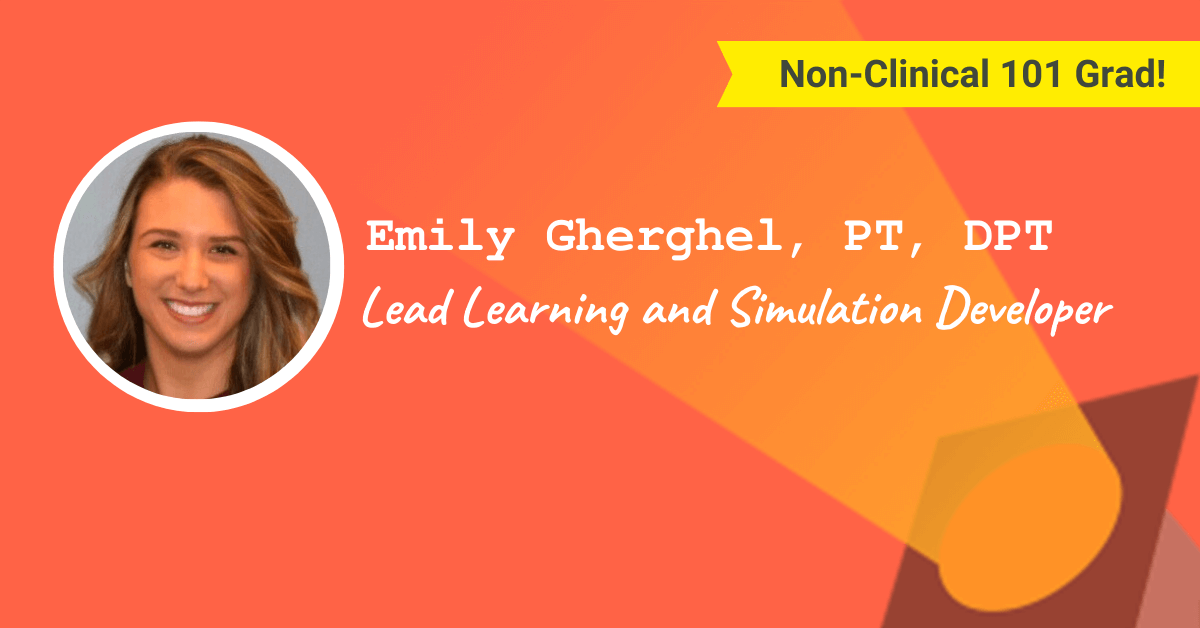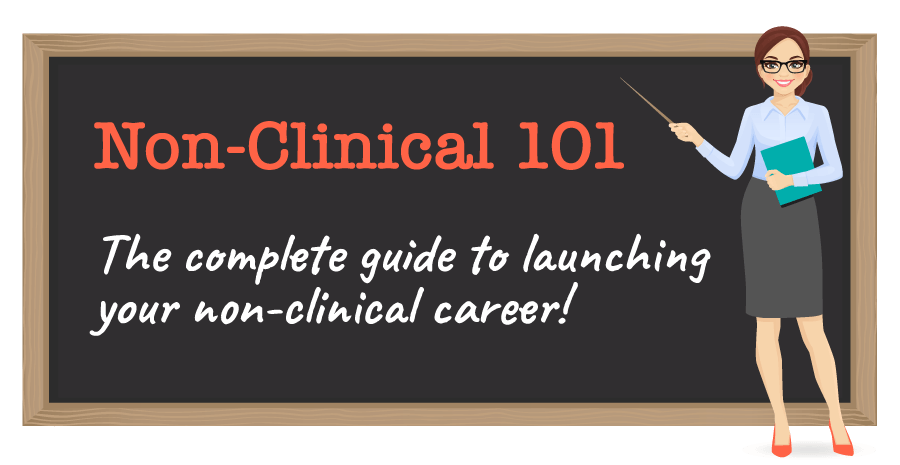This week’s spotlight features a Non-Clinical 101 graduate and physical therapist who works as lead learning and simulation developer at a clinical simulation company! She’s also a dear friend of mine, so I’m extra excited to share this with you!
This post may contain affiliate links or codes. This won’t increase your cost, but it helps keep TNCPT alive, and free of annoying ads! Thank you for your support. 🙂
What is your full name, title, and company name for your current, primary role?
Emily Gherghel, PT, DPT – Lead Learning and Simulation Developer for Simucase, LLC
Where are you located?
Rochester, NY
Where did you go to PT school, and what year did you graduate?
Misericordia University, 2017
What did you do when you first finished school, and for how long?
Immediately after graduating, I jumped into the world of travel therapy. I wanted to work with underserved populations, be challenged in my clinical skills, and explore new parts of the country.
In what settings did you work, and what types of patients did you treat?
I worked in SNF and home health settings.
Most of the patients I treated at that time were medically complex with cardiopulmonary diagnoses and post-op joints, but it widely varied.
What did you enjoy about your early roles? What didn’t you enjoy?
I loved the constant challenge of home health. It required me to practice at the top of my license. Each day, I had the opportunity to use all of the clinical tools we are taught such as auscultation and wound care.
I also loved the interactions and communications I had with other disciplines such as SLP, OT, and nursing. I was fortunate enough to work with some excellent clinicians and teams.
One thing I didn’t always enjoy was driving 400+ miles a week, as that became exhausting! Another aspect that was difficult was when I encountered clinicians or insurance companies who weren’t always acting with the patient’s best interest in mind.
When and why did you decide to do something non-clinical?
Early on, while still in PT school, I considered ways that I might be able to have a bigger impact on patient populations and healthcare as a whole. It’s important to me to always be challenged, growing, and to be able to create something.
Whether or not that was something non-clinical, I knew that I wanted to contribute in a larger way than just strictly patient care.
What are you doing these days?
In my current role, I develop computer-based physical therapy simulations. I helped to launch this program from its initial conception.
I also serve on a committee within my state PT organization, and as a peer reviewer for an allied health journal.
Are you still treating patients, or are you solely non-clinical?
Occasionally, I see patients on a per diem basis. Home health will always have a soft spot in my heart. I love being able to treat patients within their sacred space and work on goals that are the most meaningful to them.
How long have you been in your current role?
About three years!
Did you get any special certifications or training along the way to help you get into your current role?
There are a few things that helped me transition into this role. First, I was fortunate enough to have amazing mentors: one, The Non-Clinical PT herself, and the second, a former PT professor. Both mentors encouraged me to apply for the role.
Second, I took the Non-Clinical 101 course to hone my resume and cover letter. I realized we don’t always learn about these pieces of our careers in PT school. It was helpful to have a professional (who also is a PT) help me showcase my skills, attitude, and knowledge!
Third, I attended a great event called the Women in PT Summit. This event introduced me to some tremendously inspiring women working in both clinical and non-clinical PT roles. As an impressionable student, that event encouraged me to dream big and non-traditionally for my career.
I also served as a teaching assistant for two courses in my final year of PT school. That’s where I first learned how much I enjoyed combining my English Literature undergraduate degree with PT theory and concepts by writing test questions and paper lab cases.
How did you find your job? Did you apply or find it through a connection?
I found it through a referral by The Non-Clinical PT!
How have people reacted to you leaving patient care?
I’ve experienced only positivity and encouragement from both colleagues and family.
What’s a typical day or week in the life like for you as a simulation developer?
I’m often networking with expert clinicians, developing simulations according to best clinical practices, meeting with internal and external stakeholders, and managing task tickets across departments.
What are some of the rewards of your role? What are the biggest challenges?
The most rewarding part of my role is sharing each patient’s story in a virtual, interactive format so that decades of students can learn from them. This is definitely my “why”.
I am afforded a large amount of autonomy to be as creative as I can be in solving problems. This is extremely important to me as I’m a person who likes to build things and create.
I’m also so fortunate to work with a fantastic group of colleagues who support one another.
A challenge would be the fast paced nature of the work. It’s always an exercise in time management!
How did your clinical PT background prepare you for this role?
My clinical background is extremely important in this role because it allows me to anticipate and understand educational gaps. I have an awareness of the complex clinical situations that students struggle with, having worked in those very environments myself.
Some skills that transferred well into this role are an extreme attention to detail, and thinking in a systematic, procedural fashion. I think being a person who deals well with ambiguity is also important, because while you won’t always have the answers, you can always be determined to figure it out. I certainly learned how to deal with that during travel home health contracts.
What type of person do you think would do well in your role?
Someone who would thrive as a simulation developer will be detail-oriented, curious, and self-driven. They may also have a creative streak.
Do you work remotely or onsite?
Does Simucase hire PT, OT, or SLP professionals into non-clinical roles?
Yes! I work with fellow rehab professionals and social workers.
What is next for you? What are your high-level career aspirations?
My values are to always keep growing, be challenged, make an impact, and of course, have fun.
I still have a lot to learn in my role and a long runway ahead for what we’re building!
What words of wisdom do you have for someone who is considering going into a simulation developer role?
Believe in the value that you can bring to a role. Figure out your core values and design your life around those first, and then the role will come. Don’t be afraid to take that chance you’re thinking of taking.





